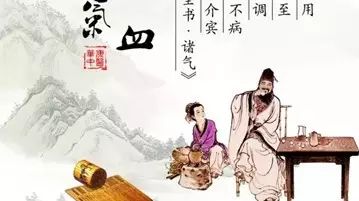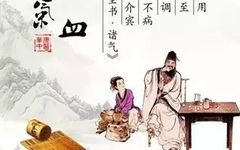

Qi (气) and blood (血) are closely related in physiology, and their pathological conditions often influence each other. Qi stagnation (气滞) can lead to blood stasis (血瘀), and prolonged blood stasis can, in turn, obstruct the flow of Qi, affecting its rising and descending functions. Thus, it is said: “Qi stagnation often causes distension, while blood stasis often causes pain. The pain from Qi stagnation is usually a distending pain, with no fixed location; the pain from blood stasis is often sharp and localized.”

In modern times, the fast-paced lifestyle, high stress, frequent late nights, and lack of exercise have all contributed to the occurrence of Qi stagnation and blood stasis. Individuals with this constitution need to regulate their Qi and blood. So, how can we improve this condition of Qi stagnation and blood stasis?
Qi stagnation and blood stasis refer to a pathological state where both Qi stagnation and blood stasis coexist. The syndrome of Qi stagnation and blood stasis arises from the obstruction of blood flow due to Qi stagnation (including functional disorders or decline), leading to symptoms of blood fatigue.
In TCM theory, the flow of blood relies on the propulsion of Qi. When Qi flow is obstructed, blood loses its driving force, leading to stagnation and forming blood stasis (瘀血) in certain areas.
Qi stagnation and blood stasis often begin with poor Qi flow, causing blood flow to stagnate; thus, Qi stagnation leads to blood stasis. Conversely, blood stasis can also obstruct Qi flow, leading to Qi stagnation. Additionally, injuries such as sprains can cause both Qi stagnation and blood stasis to occur simultaneously.
Causes of Qi Stagnation and Blood Stasis Syndrome
This condition is primarily related to emotional stress and dysfunction of the liver’s ability to disperse Qi. Qi is responsible for moving blood, and the circulation of blood in the body relies on the propulsion of heart Qi, the distribution of lung Qi, and the dispersal of liver Qi. Therefore, TCM holds that “Qi is the commander of blood,” meaning that when Qi moves, blood moves. Furthermore, external injuries such as falls or sprains can lead to local Qi stagnation, obstructing blood flow and resulting in traumatic Qi stagnation and blood stasis syndrome.
Main Symptoms of Qi Stagnation and Blood Stasis
Slow and obstructed blood flow is often due to long-term emotional repression, prolonged exposure to cold environments, or dysfunction of the internal organs, primarily affecting individuals with a lean physique.
Clinical Manifestations
When blood stagnates in certain organs or meridians, it causes localized pain that is persistent and may worsen with warmth, potentially forming lumps. Individuals with this condition may develop age spots prematurely, experience persistent pain in certain body parts, such as menstrual pain in women or frequent bruising in men, with pain often worsening at night.
Constitutional Characteristics
-
Hair loss;
-
Dark-colored lips, especially noticeable at the lip margins;
-
Purplish tongue body or spots, with mild cases showing intermittent symptoms, while severe cases have persistent symptoms;
-
Dark circles around the eyes, with purple-black eyelids;
-
Skin that is dull and lacks luster, rough texture, dry, and flaky, resembling fish scales;
-
Thickened and hardened fingernails or toenails, with mild cases showing uneven surfaces and white stripes or spots;
-
Fixed pain in the head, chest, abdomen, back, waist, or limbs that occurs frequently;
-
Frequent bloating and discomfort in the stomach area upon pressure;
-
Women often experience dysmenorrhea or amenorrhea.
Health Preservation Methods
Individuals with blood stasis constitution have conditions related to Qi and blood stagnation. Once Qi and blood stagnate, they can transform into cold or heat, or even mix with phlegm and stasis. The fundamental method for health preservation is to invigorate blood circulation and resolve stasis. It is best to adjust one’s Qi and blood, consume foods or tonics that invigorate blood circulation, engage in exercises beneficial for heart and blood vessels, and maintain a healthy psychological state. The effects of internal cultivation therapy combined with thermal magnetic meridian therapy are remarkable; friends with Qi stagnation and blood stasis may consider trying it.
Mental Health Maintenance
For individuals with blood stasis constitution, it is important to cultivate an optimistic emotional state. A cheerful spirit promotes smooth Qi and blood flow, benefiting the improvement of blood stasis constitution. Conversely, if such individuals fall into depression or melancholy, it can exacerbate blood stasis tendencies. Maintaining a comfortable and smooth mood is crucial for the health of those with blood stasis constitution.
“Human life is as long as Yang Qi,” and “when upright Qi is preserved internally, evil cannot invade.” From a TCM perspective, all diseases and sub-health conditions stem from insufficient Qi and blood or abnormal Qi flow. Unique internal cultivation methods directly replenish Yang Qi, adjust the body’s Qi flow, and regulate organ functions without the use of any products or instruments, effectively treating various diseases and sub-health conditions, especially for organ-related diseases!
Health Consultation WeChat: xbrrr699

